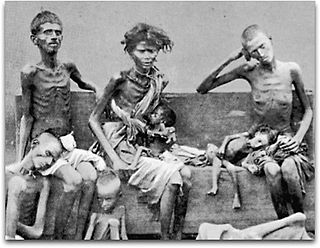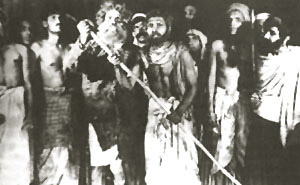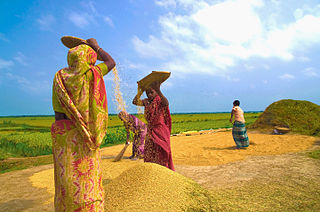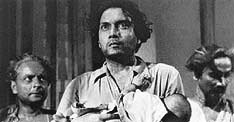
The Bengal famine of 1943 was a famine in the Bengal province of British India during World War II. An estimated 2.1–3 million, out of a population of 60.3 million, died of starvation, malaria, and other diseases aggravated by malnutrition, population displacement, unsanitary conditions and lack of health care. Millions were impoverished as the crisis overwhelmed large segments of the economy and catastrophically disrupted the social fabric. Eventually, families disintegrated; men sold their small farms and left home to look for work or to join the British Indian Army, and women and children became homeless migrants, often travelling to Calcutta or other large cities in search of organised relief. Historians usually characterise the famine as anthropogenic (man-made), asserting that wartime colonial policies created and then exacerbated the crisis. A minority view holds, however, that the famine was the result of natural causes.

Famine had been a recurrent feature of life in the Indian sub-continental countries of India, Pakistan and Bangladesh, most accurately recorded during British rule. Famines in India resulted in more than 60 million deaths over the course of the 18th, 19th, and early 20th centuries. Famines in British India were severe enough to have a substantial impact on the long-term population growth of the country in the 19th and early 20th centuries.

The Bengal Famine of 1770 was a famine between 1769 and 1773 that affected the lower Gangetic plain of India from Bihar to the western Bengal region. Warren Hastings’s estimate of the famine mortality was 10 million, or one third of Bengal's population at that time, but modern scholars estimate a much lower and more plausible revised number, in the range of around 1.2 million Bengalis, who were killed within 6–7 months.

Indian People's Theatre Association (IPTA) is the oldest association of theatre-artists in India. IPTA was formed in 1943 pre independence India, during which it promoted themes related to the Indian freedom struggle. Its goal was to bring cultural awakening among the people of India.

Bijon Bhattacharya was an Indian theatre and film actor from West Bengal.He was an eminent playwright and dramatist.

Bengali theatre primarily refers to theatre performed in the Bengali language. Bengali theatre is produced mainly in West Bengal, and in Bangladesh. The term may also refer to some Hindi theatres which are accepted by the Bengali people.
Famous Indian Theatre Practitioner

Nobanno is a Bengali harvest celebration usually celebrated with food and dance and music in Bangladesh and in the Indian states of West Bengal, Tripura and Assam's Barak Valley. It is a festival of food; many local preparations of Bengali cuisine like pithe are cooked.
Dharti Ke Lal is a 1946 Hindustani film, the first directorial venture of the noted film director Khwaja Ahmad Abbas. It was jointly written by Khwaja Ahmad Abbas and Bijon Bhattacharya, based on plays by Bhattacharya and the story Annadata by Krishan Chander. The film had music by Ravi Shankar, with lyrics by Ali Sardar Jafri, Nemichand Jain, Vamiq, and Prem Dhawan.

This is a timeline of major famines on the Indian subcontinent during British rule from 1765 to 1947. The famines included here occurred both in the princely states, British India and Indian territories independent of British rule such as the Maratha Empire.

Komal Gandhar, also known as A Soft Note on a Sharp Scale, is a 1961 Bengali film written and directed by legendary film maker Ritwik Ghatak. The title refers to the Hindustani equivalent of "E-flat". It was part of the trilogy composed of Meghe Dhaka Tara (1960), Komal Gandhar and Subarnarekha (1962), all dealing with the aftermath of the Partition of India in 1947 and the refugees coping with it, though this was the most optimistic film of his oeuvre. The film explores three themes juxtaposed in the narrative: the dilemma of Anusuya, the lead character, the divided leadership of IPTA, and the fallout from the partition of India.
Khaled Choudhury was a theatre personality and artist of Bengal. He worked for various directors of both Bengali and Hindi plays, including Sombhu Mitra, Tripti Mitra, and Shyamanand Jalan in various capacities — creating the Stage, sets and costumes and later as Music Director. He was a bachelor. He has been awarded the Padma Bhushan for his contribution to theatre in India's Republic Day Honours List on 26 January 2012. He died on 30 April 2014 in Kolkata.
Tripti Mitra was a popular Indian actress of Bengali theatre and films, and wife of Sombhu Mitra, noted theatre director, with whom she co-founded pioneering theatre group Bohurupee in 1948. She has acted in films like Jukti Takko Aar Gappo and Dharti Ke Lal.

The group theatre of Kolkata refers to a tradition in theatres in the Indian city Kolkata, which developed in the 1940s as an alternative to entertainment-oriented theatres. As opposed to commercial theatres, group theatre is "a theatre that is not professional or commercial", characterized by its tendency for experimentation in theme, content and production, and its aim of using the proscenium stage to highlight social messages, rather than having primarily making-money objectives.

Chinnamul was a 1950 Bengali film directed by Nemai Ghosh. This was the first Indian film that dealt with the partition of India. The story revolved around a group of farmers from East Pakistan who were forced to migrate to Calcutta because of the partition of Bengal in 1947. Russian film director Vsevolod Pudovkin came to Calcutta at that time, watched this film, and being inspired, he bought the print of this film to release in Russia. The film was shown in 188 theaters in Russia.

Sunil Janah was an Indian photojournalist and documentary photographer who worked in India in the 1940s. Sunil Janah is internationally acclaimed for documenting India's independence movement, its peasant and labour movements, famines and riots, rural and tribal life, as well as the years of rapid urbanization and industrialization. Noted for the beauty and technical quality of his compositions, Sunil Janah's photographs are significant in their historical content as well as their emotional connect. He was best known for his coverage of the Bengal famine of 1943. The Government of India awarded him the civilian honour of Padma Shri in 2012.
Kumar Roy (1926–2010) was a Bengali theatre actor, director and playwright. In 1983 he won the Sangeet Natak Akademi Award. He was associated with the group Bohurupee. In 1989 he directed the re-creation of the classic play Nabanna (1948). He was the President of the PashchimBanga Natya Akademi from 2006 till his death in 2010. Kumar Roy was also Professor of Drama at Rabindra Bharati University, Kolkata and Visiting Professor at Sangeet Bhavan, Visva-Bharati, Santiniketan.
Tapas Sen was a noted Indian stage lighting designer, who was an important figure in 20th-century Indian theatre. He started working with Bengali theatre movement in Kolkata in the late 1940s, along with noted directors, Utpal Dutt and Shambhu Mitra. Later he became a founding member of the Indian People's Theatre Association's (IPTA), Delhi chapter, and worked closely with Hindi theatre. Through his career stretching five decades he worked theatre directors, Ebrahim Alkazi, Vijay Tendulkar, and also dancers Sadhana Bose, Chandralekha, Birju Maharaj and Kelucharan Mahapatra. He was known not only for his creative stage lighting, but also had a significant impact on the work of leading theatre director of the time.
Dilip Bagchi was a Bengali mass singer, educationist and political activist. He was an active member of Indian People's Theatre Association of West Bengal.
The Bengal famine of 1943-44 was a major famine in the Bengal province in British India during World War II. An estimated 2.1 million, out of a population of 60.3 million, died from starvation, malaria and other diseases aggravated by malnutrition, population displacement, unsanitary conditions, and lack of health care. Millions were impoverished as the crisis overwhelmed large segments of the economy and social fabric.












